
Castle of the Holy Angel seen from Ponte Sant’ Angelo.
Castel Sant’Angelo or in English Castle of the Holy Angel, was the Mausoleum of Hadrian, Emporer of Rome in the second century. It sits by the river of Tiber. It leaves one with a massive impression, not because it’s particularly beautiful, because it isn’t, but yet, it fascinates. It used to be the tallest building in Rome.
Shooting photos in Rome at night, is great fun, but also a big problem when you start post processing the photos. The city lights are VERY yellow, even when you are on location and looking at it. When we walked around and shot photos along the River of Tiber, I just knew that colors would be a problem. This is not the first time I have encountered such yellow city lights. I also experienced it Rothenburg ob der Tauber in Germany. They use some kind of LED lamps, with a very yellow glow.
The problem with yellow lamps is that you don’t really get a lot of colors reflected back. Think back to the old days with a dark room. The red light bulb made a white piece of paper seem complete red, even if you knew it was white. The same thing happens with a yellow lamp. The light almost only has yellow colors in it, and the only colors they really reflect is yellow. It’s a strange concept the first time you run into it. A surface can only return, the colors that the light source contains.
Once I heard a question ‘what color is the Moon really?’ and the answer got very complex, exactly because of the colors the light contains, and that different colors have different wavelengths.
In my world, the color of light is less complex than wavelengths, it’s just a couple of sliders in Adobe Lightroom.

On the left you see the fixed white balance, and on the right you see the out of camera white balance.
Usually, the color of city lights is somewhere between 2200 kelvin and 3300. Modern LED lamps tend to be in the lower end of the span, but there is only way to find out, and that is by adjusting the temperature.

This usually brings you to the right temperature, but with the city lights of Rome, I found that I hit the bottom, which is 2000 degrees Kelvin, before I am happy. And I am only JUST happy and not really happy. No flexibility at all.

This is much better, but there is still a purple and yellow hue to the statue. To adjust this, I can use the Tint slider, but before doing that, I will show you a little trick. The trick will make it quite easy to find the best possible white balance much easier.
Tip: Before adjusting the temperature and tint slider, I dial up the Vibrance and the Saturation to 100. I am not going to leave them in this place, but it makes it easier to spot color casts because they are exaggerated.

I adjust the Temperature and the Tint to find a compromise. My aim is to balance the amount of blue and yellow and purple or green. This IS a compromise, but when the balance is found, I have found the best possible white balance. I will have to make local adjustments to make changes to it.
Typically this is a real problem if there are mixed light source, it could be electrical and natural light or just different sorts of electrical light.
This is what I ended up with, after using the trick:

While this has got a little more purple, it also has less yellow. It turned out, that some of the yellow really was too much green. The compromis is to accept a bit more purple in the image over all, but purple can be removed, using the HSL panel, in Lightroom, if need be (so can yellow for that matter).
When I dial the Saturation and Vibrance back to 0 I get this acceptable result:

And the full image looks like this:

I still had to work with the colors, but in general I have am rid of the super duper yellow image, and have something in the natural world. There is a purple hue, but that can fairly easy be removed using either Photoshop or Lightroom.
From here I did my Photomatix and Photoshop blend images show.
These are a couple of other examples of city night shots, that had a real strong yellow orange glow to them before I started processing them:

Cold evening at the Bean in Chicago.

Rothenburg split road. Not as vibrant as it could have been, if not for the strong yellow city light.
This trick on white balance I have showed you here is the easiest and fastest way I have found so far to do a pretty accurate white balance.
–Jacob Surland









